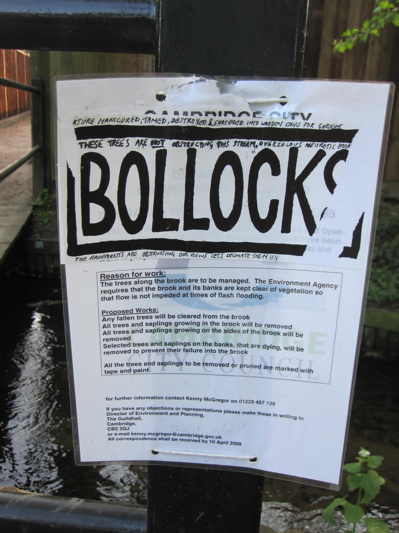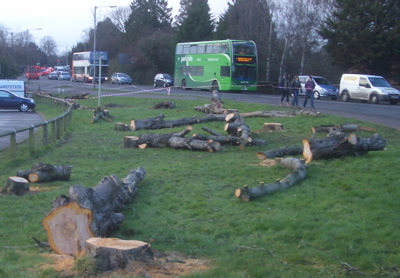
Cambridge City Council’s new policy for consulting on tree works was taken to the Council’s Strategy and Resources Scrutiny Committee on the 29th of June 2009.
I had commented on the new protocol prior to the meeting. Suggestions from me and others were included in the report to the committee but council officers had decided to recommend councillors ignore many of them. I attended the meeting and spoke in person to urge them to make the amendments I thought were required. Two of my suggestions were then enacted.
Requiring Objections on Bits of Dead Tree
I suggested that the proposed requirement for objectors to tree works to have to submit a signed paper copy of their objection ought be removed. I said I wanted an email or online form response to be sufficient. I said the requirement for a signed letter was not going to promote accessibility and openness, and was not in line with the aims of E-Government.
Cllr Walker agreed with me, she asked why, as the planning department accept emails objecting to planning applications, was the council not prepared to accept them in relation to tree works.
Diana Oviatt-Ham, one of the council’s many tree officers responded, she said that the suggested protocol was intended to ensure that only valid objections were considered. She then said that the planning department operated entirely by post and not electronically. Simon Payne the Council’s Director of Environment and Planning commented on my suggestion to allow email objections, saying : “the concern there is that when people make representations we need to ensure they are properly considered truthful objections by people who really exist. We are aware of cases in other local authorities where they have been deluged by emails from all around the world creating lots of extra work”.
Cllr Ward said that he wouldn’t expect council officers to send personal responses to hundreds of objectors from South America. He said that that it was not who was making the representation that was important, it was the substance of that representation.
The leader of the council, Ian Nimmo-Smith spoke to say the decision had come to him as trees were a “cross cutting” issue involving many departments. He called for the process to initially be “reasonable and unconstrained”, for email responses to be allowed. He also corrected his officers, reminding them that the planning portal allowed people to make representations online.
The meeting and the council’s leader agreed to amend the protocol to allow email objections.
Restricting Objections to Those who Live and Work in the City
Cllr Blair had responded to the consultation on the new decision making protocol to request that only those who live and work in the city be allowed to object to tree works. Officers were recommending her suggestion be acted on and the restriction imposed in the new protocol. When I spoke I argued against the restriction, pointing out it excluded many who had a legitimate and substantial interests in the city. First the leader of the council agreed with me, giving the example of landowners who live outside the city as an important group who would have been excluded, then the committee also agreed and, along with the leader, amended the protocol.
Speaking at Planning Meetings
I suggested that the rules for speaking at planning meetings ought be relaxed for tree items. I suggested that people might miss the short formal consultation period during which formal objections can be made, and that people who had not objected might want to attend the planning meeting and try and influence councillors immediately before they make their decision. Diana Oviatt-Ham responded to say that she felt the rules for speaking at planning meetings were adequate – requiring notice to be given before noon on the working day before the meeting. Councillors agreed with her.
Promoting Tree Consultations
I suggested that councillors ought be more prescriptive about the quality of background information about proposed tree works. I suggested dedicated webpages with photographs, the argument for the works, and a comment form. I suggested that documents ought not be buried deep on the website (the city council often releases information PDFs linked only from other PDFs).
Diana Oviatt-Ham said that the information, in its current form, was acceptable. But also said there was a longer term plan for improvement as part of “tranche five” of the new customer access strategy. (The spending of money on this process, led by Cllr Cantrill, has been delayed). Diana Oviatt-Ham said details of current works were already on the site. I believe this was another lie to the committee (following her lie about the planning department not accepting email objections) as I can find no details of any current tree works listed on the page which she referred to.
Vicar’s Brook
I asked specifically about the Vicar’s Brook trees. I noted this had been one of the decisions where the new protocol had been trialled, and there had been no public information about what was happening for many weeks. I suggested the information on the point in the process which had been reached ought be publicised. I suggested that the flaws seen in this case ought be dealt with.
I was told that the Executive Councillor had not yet made a decision – but had been sitting on it for five weeks.
Self-Seeded Saplings
I asked about the status of self-seeded saplings in the protocol. Cllr Ward had the week before described saplings at the Paradise nature reserve, which it is proposed to fell, as “weeds made of wood“. Diana Oviatt-Ham took a different view, saying that she felt the works ought be considered major works, as they came under the classification of a : “schedule of minor works that would have a significant cumulative impact on a landscape character or habitat. ”
Other contributions to debate
Cllr Taylor, the meeting’s chair said: “there has been a great amount of public interest in how we manage our trees” while introducing the item.
Simon Payne the Council’s Director of Environment and Planning described the protocol as: “a major step forward but drew attention to the need to balance effectiveness with value for money”. He cautioned that more officer time would be required to operate the new system, and that a request for a greater budget might be made in the future.
Cllr Bick made the unnecessary request for a simple, publically accessible, overview of the process in addition to the formal protocol which was written in obtuse language presumably intended to act as guidance for officers. The report to the committee clearly stated this was already intended. Cllr Bick revealed he had attended a secret meeting with unnamed interested parties along with the council’s tree officer Diana Oviatt-Ham. I believe that those who voted for him as a Liberal Democrat would expect openness and transparency.
Cllr Walker questioned the need for two committees, and suggested the Planning Committee ought just make the decisions. She pointed out how two committees meant lots of extra work for councillors, objectors, and officers. Council officers said that legally the decision to do tree works was an executive matter, and had to be taken by the executive councillor. They pointed out that the need for a second committee would only arise when the executive councillor disagreed with the planning committee and suggested this would not happen in 99% of cases.

Cllr Walker also asked about progress towards ensuring the protocol covered all trees in the public realm. She asked for an update on any work to get the County Council and other bodies to sign-up to a consultation process prior to tree works. She was told there had been limited progress, but some discussion with the county council had taken place. Diana Oviatt-Ham, rather irrelevantly noted that the council had, on occasion, placed a Tree Preservation Order on a tree to protect it from the highways authority. She cited East Road and Huntingdon Road. Cllr Bick also followed up on this, saying he thought the plan was that other organisations would be asked to sign up to the protocol. The tree officer said that while the county council were keen on consulting, they had not yet decided “how to resolve objections”. She also suggested that there was a need to deal separately with the Education Authority, Highways Authority and County Council. They are all one and the same! Cllr Ian Nimmo-Smith urged further work with respect to getting the “wider public realm” included in the protocol, he suggested starting with the Highways Authority and suggested others ought be added. He referred to the felling of the cherry trees at Addenbrookes as an even which ought to have been consulted on. It was interesting to hear the Leader of the Council using words and expressing a view completely in line with that proposed by the opposition when the tree protocol was discussed at full council.
Cllr Dryden said he was not happy that councillors approval of works would be assumed if they did not respond to a consultation within five days. He said that on occasion his email didn’t work, or he was away from it for periods of longer than that. He didn’t think his approval ought be assumed on the basis of a non-response.
3 responses to “Cambridge City Council Adopts New Protocol for Making Decisions on Tree Works”
Councillors who are not happy with the ‘5 days and you’re out’ policy for assumed approval, should set up a scheduled task which sends, at daily intervals, an email saying, “I object to the latest tree-felling proposals.”
I recall the tree preservation orders for the St Matthews playground in East Rd. Frankly they had little to do with the quality of the trees (largely saplings) on the grassy bank and everything to do with delaying the works to dig them up (preparatory to widening East Rd)until after the impending County Council elections. At the election, the then Conservative County Council was dislodged and the decision to widen the road reversed. A belated round of applause for former councillor Frank Gawthrop (whose idea I believe it was). A splendid piece of representative democracy in action. Possibly something of an abuse of tree preservation powers (which is why they had to do it twice) but entirely necessary at a time when grassy bank preservation powers did not exist. As they still don’t, of course. _
Yes, kudos to Cllr Gawthrop, but it was also a rare example in Cambridge of people power in action. Parents and others went down very early in the morning to the school and barred the vehicle entrance. They then sat down around thee trees preventing their felling, I assume until the city council TPO came into force. Their action prevented the tree removal, and the reduction in the playground due to the proposed East Road widening. Don’t forget that the County had (has?) a long term plan to dual cariageway all of East Road, and Gonville Place (and presumably further) as an inner orbital route. Could it happen now we wonder?